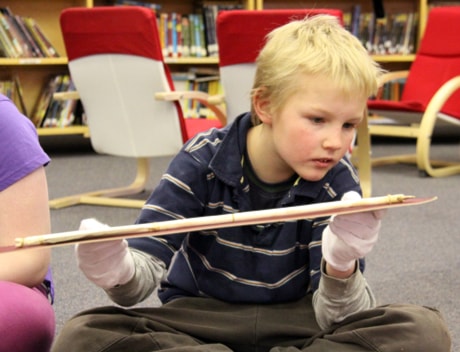Sitting on mats around the circle are bone tools, decorative shells and even an orange-coloured fox skin.
The Grade 4 students at John Wilson Elementary School in Innisfail sit behind each item, examining each with care, wearing white gloves and handling each piece as delicately as they would a fragile egg.
It’s part of a special program recently developed through Chinook’s Edge School Division that allows students to learn about aboriginal stories and artifacts, as part of a presentation and artifact kit put together by Iris Loewen, First Nations, Métis and Inuit library co-ordinator with Chinook’s Edge.
“The idea is that the artifacts tell us stories and so when we learn those stories, we learn again what is valuable to the people who used them,” Loewen said. “Optic-based learning is the kind of learning that research shows engages students in ways that sitting in the classroom doesn’t always do. Students are more engaged in this kind of work.”
The students in Grade 4 teacher Corinne Jewell’s class lifted the items up, examining them and even smelling them to try to figure out what they were used for. Some seemed relatively obvious, such as an arrow or a hand drum, others were more of a mystery.
Sarah McLaughlin figured out that her item was a doll and thought it was made out of grass but it turned out the doll, which was around 20 cm in height, was made out of cattails, with hands that moved and little feet.
“It was really good. I really enjoyed it,” said McLaughlin about the presentation. She said she liked seeing the different animal skins and finding out how each of the items worked and was used.
Tim Gulliford, another Grade 4 student in the class, said he first thought that the artifact in front of him was a knife to cut wood but figured out it was instead a bone tool used on bison hide. He said the presentation was “awesome.”
Before looking at the artifacts, the students sat on two bison skins and heard a story about the chinook, which was trapped by a bear and freed by a number of animal friends because a boy and his tribe were freezing and needed their help. They also heard about a greedy field mouse, who killed a bison but then would not share with the fox who had helped him and wound up getting eaten by the fox. Each story, like a parable, gives hints of the importance placed on certain values in First Nations society, including courage and generosity.
Loewen quoted Basil Johnston, an Ojibway writer, who said if you want to know aboriginal people better, you need to listen to their stories, go to their ceremonies and through that you get to know what is important to them.
Besides presenting at the schools, Loewen has also created a website accessible to Chinook’s Edge teachers so they can learn more about the artifacts and use the kit to help their students explore aboriginal culture.
sobrien@www.reddeeradvocate.com
